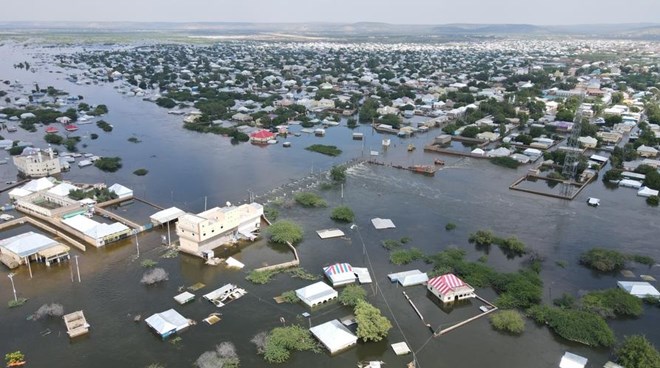
Tuesday September 24, 2024
Conflict, insecurity, and climate change have displaced more than 342,000 people within Somalia in the first eight months of 2024, according to the UNHCR.

This aerial photo shows a view of flood-hit Beledweyne, central Somalia, Nov. 20, 2023. (Photo by Abdullah Boyow/Xinhua)
MOGADISHU, Sept. 23 (Xinhua) — Conflict, insecurity, and climate change have displaced more than 342,000 people within Somalia in the first eight months of 2024, a United Nations refugee agency said Sunday.
The UN High Commissioner for Refugees (UNHCR)-led Protection and Monitoring Returns Network said some 23,000 internal displacements occurred in August alone, with 43 percent attributed to conflict, insecurity, flooding, or drought.
“Food, shelter, livelihood, water, and health were the top needs of the newly displaced families. Bari, Bay, Middle Juba, Gedo, and Lower Juba regions reported the greatest number of IDP (internally displaced people) arrivals, accounting for 66 percent of the total displacements,” the UNHCR said in its latest operational update released in Mogadishu, the capital of Somalia.
According to the UNHCR, women and children, who face heightened protection risk, make up 80 percent of the displaced population.
It said key factors contributing to insecurity across Somalia were armed conflict between the Somali security forces and al-Shabab, clan conflicts, and indiscriminate attacks by the militants. It said the overall political and security situation in Somalia remained uncertain and in flux.
The African Union (AU) approved the AU Support and Stabilization Mission, which will replace the African Transition Mission in Somalia in 2025. “This transition is critical for ongoing peacebuilding efforts and security operations in the region,” the UNHCR said.
Somalia also hosts 40,200 refugees and asylum seekers, of whom 66 percent are women and children, 30 percent are school-age children (6 years to 17 years of age), and 26 percent are women and girls of reproductive age (13 years to 49 years of age), said the UNHCR.
According to the report, Ethiopians make up the majority of refugees and asylum seekers (65 percent), with Yemen coming in second (30 percent), Syria coming in third (4 percent), and other nations coming in last (1 percent).
The UNHCR said 139,260 former refugees have returned to Somalia from their countries of asylum since December 2014, with Kenya and Yemen coming in second and third, respectively. It has directly assisted 95,206 individuals from the total number of refugee returnees, primarily through the Voluntary Repatriation Program from Kenya and the Assisted Spontaneous Returns Program from Yemen.






